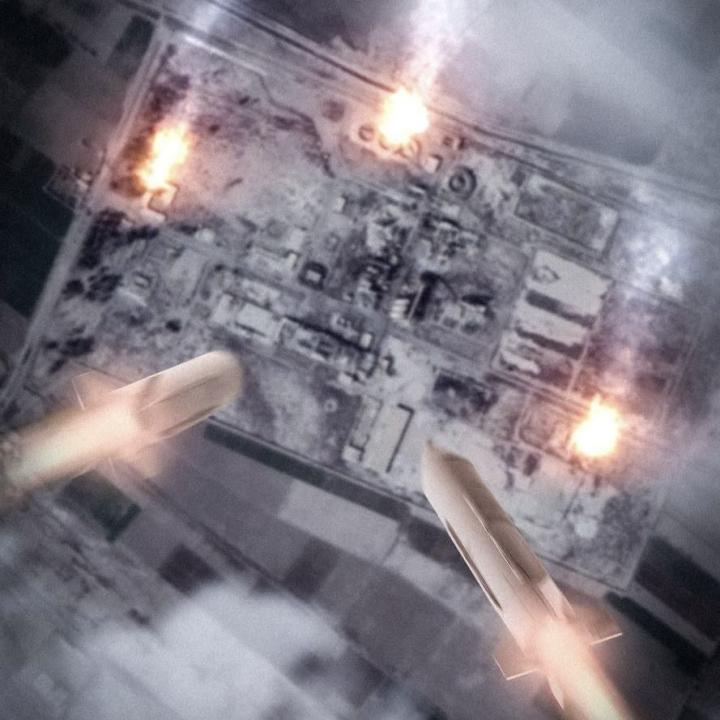
Iraqi Militias Hit Two U.S. Sites in Iraq and Syria

Iran-backed groups have adopted tight message discipline so far, not claiming either of the attacks in order to avoid U.S. retaliation while simultaneously warning Prime Minister Sudani to keep pushing for U.S. withdrawal.
Two U.S. bases—one in Syria (Kharab al-Jir) and one in Iraq (al-Asad Air Base)—have been attacked in the past day, the first militia strikes on American facilities since February 4. Open-source reporting, including press agency quotes from unnamed U.S. officials, gives sufficient confidence that rockets and drones were used in each operation.
The first attack was a nocturnal (21:50 Baghdad time, April 21) launch from Ahmed Agha in northern Nineveh, Iraq, to the Kharab al-Jir (Rmelan Landing Zone) in northeastern Syria. Seemingly a high-angle 122-millimeter rocket launch, the strike saw at least five projectiles fired toward Syria. Iraqi security forces claimed that they burned the launch vehicle, but video suggests it caught fire during launch (Figure 1). Kharab al-Jir is a target location that has been almost exclusively associated with the muqawama (resistance) group Harakat Hezbollah al-Nujaba.
The second attack was a drone strike on al-Asad Air Base in Anbar, originating from an unknown launch point in Iraq or Syria. This target location has been almost exclusively associated with the U.S.-designated terrorist group Kataib Hezbollah (KH). A Shahed-101 drone that might have been part of the same daylight attack stream was found on April 22, crashed in Madain at the western edge of Wasit province.
Militia Reporting on the Kharab al-Jir Attack
Starting around 22:00 Baghdad time on April 21, the Kharab al-Jir strike was initially reported as a drone attack by most muqawama Telegram accounts (Figure 2), but then a Reuters account released at 23:15 quoted security sources saying it was a rocket attack. After the Reuters report, muqawama social media reported the incident as a rocket attack rather than a drone attack (Figure 3).
At 04:31 Baghdad time on April 22, the militia outlet Sabereen News noted explicitly that KH (which has been under a self-imposed truce with U.S. forces since it killed three Americans in Jordan on January 28) had not taken any responsibility and did not “issue any statement in the past forty-eight hours” (Figure 4). This was in response to social media posts claiming that KH had in fact taken responsibility for the Kharab al-Jir attack.
Similarly the Islamic Resistance in Iraq (IRI) umbrella brand has not taken responsibility for either attack yet, nor even made any comments about them. Since KH halted its attacks in late January, the original IRI Telegram account was abandoned and a new one under the control of Nujaba was created in early February. The new IRI account has exclusively taken responsivity for claimed drone and cruise missile attacks against Israel.
Al-Asad Drone Strike
On April 22, Reuters quoted a U.S. official stating that al-Asad Air Base in western Iraq had been targeted with an explosive drone. Curiously, this attack went largely unreported by muqawama social media, which is usually very quick to report and amplify news of such attacks. No muqawama accounts foreshadowed the attack either, which they have commonly done in the past.
Is the Ceasefire Over?
Militia Telegram channels have expressed growing frustration toward the U.S.-led coalition in recent days, relating to perceived delays in its withdrawal of forces from Iraq and its role in supporting Israel against Iran. On the surface, this frustration suggests a fraying of grassroots acceptance about maintaining the ceasefire.
In Militia Spotlight's view, the two attacks were not a breach of discipline but rather a coordinated act by Nujaba and KH, likely with the approval of Iran's Islamic Revolutionary Guard Corps-Qods Force (IRGC-QF). The objective was likely to signal disapproval to Prime Minister Mohamed Shia al-Sudani as he returned home from Washington, reminding him who rules Iraq and prodding him to press the coalition for a concrete withdrawal timeline.
Evidence of coordination—which tends to reflect IRGC-QF involvement—is visible in both the operational space (i.e., discrete targets strongly associated with the two main kinetic actors in the Iran-backed muqawama, Nujaba and KH) and the online space (i.e., message discipline). The action was also carefully executed, with no U.S. casualties and no inferred claims of responsibility—indeed, a denial of involvement. Efforts were thus made to avoid escalation that might draw KH and Iran into danger.
No Humble-Bragging Allowed
The muqawama media behavior surrounding these two events may suggest that a new approach has been adopted across the networks, including both KH and Nujaba sub-networks, which is often indicative of coordination by the IRGC-QF. The fasail (armed groups) may be testing U.S. resolve, and doing so in a way that makes it easier for the Washington to ignore: namely, with attacks that are well below the typical U.S. retaliatory threshold and are not celebrated by major muqawama channels. At this stage, Iran, Nujaba, and KH may value complete plausible deniability above other considerations, making it harder for the United States to attribute the attacks to a particular militia, and therefore may have tightened their social media space.










